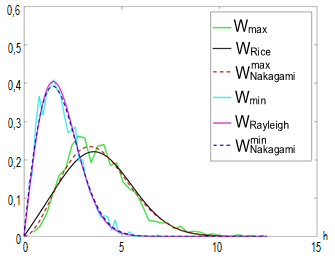
Increasing the probability of transfer GMDSS broadcast messages when transmitted over HF channel in case fading
https://doi.org/10.31854/1813-324X-2024-10-1-58-64
EDN: PPLZCM
Abstract
Improving the quality of communication in the Global Maritime Distress and Safety System of navigation is one of the components of the development of the Arctic zone of the Russian Federation in terms of information support. At the same time, the most difficult is to ensure communication in the A3 and A4 areas, where a communication HF channel plays a not small role. The transfer of messages over HF channel in the broadcasting mode of SITOR-B is considered. To improve probabilistic characteristics in the work, a statistical analysis of the decisions of the demodulator is carried out. It is shown that the probability density functions are “noisy”, which is associated with the non-zero probability of a bit error. Models of Rayleigh, Rice and Nakagami distributions were used for statistical analysis. It is shown that in the case of low values of the signal-to-noise ratio, which is characteristic of high latitude tracks, a Nakagami model is preferable. The symbol error rate and message error rate in a fading communication channel, as well as the probability of receiving an erroneous message are shown. The results presented in this work can significantly improve the probabilistic characteristics of the HF radiolines when transmitting messages in SITOR-B mode.
About the Authors
V. EgorovRussian Federation
M. Maslakov
Russian Federation
References
1. Hanychev V.V., Svirskij V.M., Borisovskij D.V. Information support for navigation safety along the Northern Sea Route. Morskie informacionno-upravlyayushchie sistemy. 2014;2(5):64−69.
2. Bazhukov I., Dulkejt I., Zavyalov S., Kosykh A., Lyashuk A., Chaschin E. Organization of Information Support for Mobile Groups of Saviors in the Arctic Zone of the Russian Federation. Dynamics of Systems, Mechanisms and Machines. 2018;6(4):3−9. DOI:10.25206/2310-9793-2018-6-4-3-9. EDN:VMCSTU
3. Dulkeyt I., Patronov K., Prokhorov P., Svirsky V. Modern trends in development of equipment of the Global Maritime Distress System of (GMDSS) MF/HF bands. Morskoy Vestnik. 2011;3(39):73−76. EDN:OCPHIN
4. Shishkin A., Kuprovskii V., Koshevoi V. Global Maritime Distress and Safety System (GMDSS). Moscow: TransLit Publ.; 2007. 544 p.
5. Ilmer D., Pomazunov S., Islamov A. Assessment of the service area of the NAVTEX system in the East-Siberian Sea. Means of communication equipment. 2023;1(161):29−47. DOI:10.24412/2782-2141-2023-1-29-47. EDN:FTCKIO
6. Koval S. Ionospheric monitoring for the benefit of perspective adaptive systems of a decameter radio: current state and prospects of development. Systems of Control, Communication and Security. 2020;4:73−100. DOI:10.24411/2410-9916-2020-10403. EDN:FCNETL
7. Dul'kejt I.V., Zachatejskij D.E., Zemlyanov I.S., Maksimov A.A., YUr'ev A.N. Adaptive MF/HF radio communication systems as a way to improve navigation safety. Problemy razvitiya korabel'nogo vooruzheniya i sudovogo radioelektronnogo oborudovaniya. 2013;2:80−87.
8. Manual of Transmission Methods. Reference Document. 4070.0711.02 – 03. Munich: Rohde & Schwarz; 2014.
9. Tikhonov V.I. Statistical radio engineering. Moscow: Sovetskoe radio Publ.; 1966. 680 p.
10. Parsons J.D. The Mobile Radio Propagation Channel. John Wiley & Sons; 2000.
11. Popovic H., Stefanovic D., Mitic A., Stefanovic I. Stefanovic D. Some Statistical Characteristics of Nakagami-m Distribution. Proceedings of the 8th International Conference on Telecommunications in Modern Satellite, Cable and Broadcasting Services, October 2007, Nis, Serbia and Montenegro. IEEE; 2007. p.509‒512. DOI:10.1109/TELSKS.2007.4376057
12. Forbes C., Evans M., Hastings N., Peacock B. Statistical Distributions. New Jersey: John Wiley & Sons; 2011. 230 p.
13. Egorov V.V., Lobov S.A. The reliability of receiving information signals esimation in the demodulation process. Proceeding of the 21st Digital signal processing and its application, DSPA, 27‒29 March 2019, Moscow, Russia, vol.XXI(2). Moscow: Scientific and Technical Organization of Radio Engineering, Electronics and Communications named after A.S. Popova Publ.; 2019. p.208–210. EDN:XCCAVT
14. Lemeshko B., Lemeshko S., Postovalov S., Chimitova E. Statistical data analysis, simulation and study of probability regularities. Computer approach. Novosibirsk: Novosibirsk State Technical University Publ.; 2011. EDN:TZNHMX
15. Gladkih A.A. Fundamentals of the theory of soft decoding of redundancy codes in an erasing communication channel. Ulyanovsk: Ulyanovsk State Technical University Publ.; 2010. 379 p. EDN:QMVTNX
16. Zolotarev V.V., Ovechkin G.V. Noiseproof Coding. Methods And Algorithms. Moscow: Publishing House Hot line–Telecom Publ.; 2004. 126 p. EDN:TPMDGJ
17. Karagiannidis G.K., Sagias N.C., Mathiopoulos P.T. N∗ Nakagami: A Novel Stochastic Model for Cascaded Fading Channels. IEEE Transactions on Communications. 2007;55(8):1453–1458. DOI:10.1109/TCOMM.2007.902497
18. Karagiannidis G.K., Sagias N.C., Mathiopoulos P.T. The N* Nakagami fading channel model. Proceeding of the 2nd International Symposium on Wireless Communication Systems, 5–7 September 2005, Siena, Italy. IEEE; 2005. p.185–189. DOI:10.1109/ISWCS.2005.1547683
Review
For citations:
Egorov V., Maslakov M. Increasing the probability of transfer GMDSS broadcast messages when transmitted over HF channel in case fading. Proceedings of Telecommunication Universities. 2024;10(1):58-64. (In Russ.) https://doi.org/10.31854/1813-324X-2024-10-1-58-64. EDN: PPLZCM

































